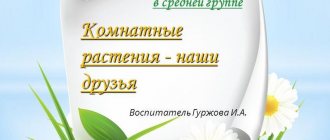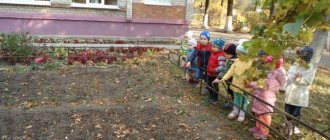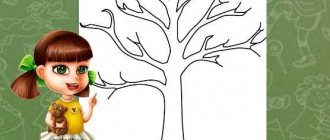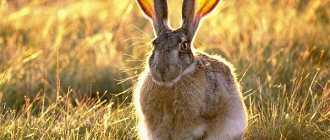Summary of the GCD “How trees prepare for winter”
- October 22, 2015
Competition “My Pedagogical Initiative - 2015”
Nomination “Methodological work in preschool educational institutions”
Topic of the lesson: “How trees prepare for winter” (using the ecological fairy tale “Girl-Autumn”).
Educational objectives:
- Consolidating children's knowledge about the signs of autumn.
- Formation of a system of knowledge about plant life in the autumn period: understanding the patterns of natural phenomena, the cyclical nature of changes in nature; concretizing children's ideas about the autumn colors of trees.
Developmental tasks:
- Development of analytical abilities: the ability to compare, analyze and establish cause-and-effect relationships and draw conclusions.
- Development of imagination, creative abilities of children, emotional sphere through play-dramatization.
- Development of figurative and demonstrative speech in children.
Educational tasks:
- Fostering in children a careful and caring attitude towards the plant world (trees) as living beings; feelings of importance and necessity of everything that happens in nature.
Materials and equipment for the lesson:
1. Tape recorder, audio recording: P.I. Tchaikovsky "Autumn" from the cycle "Seasons". 2. Autumn leaves from different trees. 3. Leaves made of colored paper (green on one side, red, yellow, brown, etc. on the other) 4. Drape and plumes for rain. 5. Wind mask and scarf. You can purchase pencils, paints, plasticine and other stationery for classes on the website www.kanc-magazin.ru
Preliminary work
Cognitive development:
1) Topic: “Nature on the territory of the kindergarten.” Objectives: To introduce children to the nature of their immediate environment, to teach them to distinguish parts of a plant, to form ideas about the connections of plants and animals with each other and with inanimate nature, to develop educational games; - 2) Topic: “Nature in the city.” Objectives: To introduce children to the nature of their immediate environment, to develop the ability to establish cause-and-effect relationships (plants and their habitat conditions). 3) Topic: “How to help nature in the city.” Objectives: To form initial ideas about environmentally conscious behavior, to help in understanding the connection between people’s behavior and the state of their environment. 4) Topic: “Who eats what.” Objectives: To form ideas about the diversity of fruits and seeds; their roles in human life; about the relationship between plants and animals. 5) Topic: “What are seeds for?” Objectives: To form ideas about fruits, their diversity and purpose, to arouse interest in research activities. 6) Topic: “Poets and writers about autumn.” 7) Theme: “Autumn is on the threshold” (based on the story by N. Sladkov; “Autumn is on the threshold”).
Productive activities.
A) Application: “Colored flowerbed”, “autumn still life”, “leaves on the window”, “gifts of autumn”. B) Modeling: Dancing leaves" (decorative, relief), "Rowan branch", "Apples" C) Drawing: "Trees in our city", "Riddles from the garden", "Autumn colors, autumn leaves" D) Construction: " Friends are pretenders" (natural material)
Didactic games:
1. “Nature and man” (the ability to distinguish between nature and non-nature.) 2. “Recognize a leaf” 3. “Find a leaf, like on a tree” (teach children to classify plants according to a certain characteristic; find a part from the whole) 4. “Wonderful bag" (to consolidate the ability to distinguish and name fruits and vegetables; highlight their characteristic features). 5. “Forest School” (consolidating children’s knowledge about forest gifts). 6. Nature “One, two, three - run to the tree” (to consolidate children’s knowledge about trees). 7. “Children on the branches”
Work outside of class:
- Examination of paintings: I. Grabar “Autumn Leaves”; K. Korovin “Autumn” Examination of illustrations depicting an autumn landscape, insects, birds, animals.
- Solving riddles on the topic: “What autumn has brought us.”
- Reading and viewing (illustrations) of books: A. Vakhrushev “World and Man”, A. Pleshakov “Green Pages”. Learning poems; K. Balmont “Autumn”, L. Divorce “Mischiefs”
Observations:
- Changes in illumination during the day;
- temperature change;
- slowing down plant growth;
- distinguishing trees, shrubs, grasses by trunks, branches, remains of fruits, leaves;
- disappearance of insects (finding places of accumulation);
- departure of insects and birds.
Progress of the lesson
1. Introductory part. Conversation about autumn.
Educator: Guys, guests came to our lesson today. Let's say hello to them. (Children say hello, go to the chairs, and sit down).
- Guys, I suggest you listen to music. (The musical excerpt “Autumn” by P.I. Tchaikovsky from the work “The Seasons” is played).
- Children, what time of year did this piece of music remind you of? Why? (Autumn, nature is sad, summer has gone, etc.)
- What time of year is it now? (Children's statements).
- Or maybe spring? (Children prove that it’s autumn outside. Signs of autumn).
Educator: One of the brightest and most noticeable signs of autumn is yellow strands in the foliage. Guys, which tree starts to turn yellow first? People have a lot of sayings about this. Who wants to tell? Expressions of children (“The linden tree blinked with a variegated leaf - autumn called”).
Educator: Well done, guys! They say there are two autumns? What are their names? (Children's statements: (early autumn or golden; the other - late).
Educator: Yes, children, one joyful autumn, lushly decorated with flowers, foliage, rich in harvest. The other is unsightly, covered in rags of falling leaves, sad with the quiet cry of rain, with heavy clouds in the sky. Guys, let's try to find a lot of definition words for the first golden autumn. (Children select definitions - beautiful, golden, colorful, luxurious, generous, rich in harvest, cheerful, bright, cool, etc.)
Educator: Listen to how beautifully the poet Tyutchev wrote about this nature:
There is a short but wonderful time in the original autumn. The whole day is as if it were crystal, And the evenings are radiant.
Educator: Guys, what words can you choose to describe late autumn? (Children's answers: cold, rainy, wet, crying, sad).
Educator: Well done! Guys, I offer you the game “Good - Bad”. Autumn is good because...(children's answers). This wonderful, fabulous autumn will bring both joy and sadness. And that's probably a good thing.
2. Main part. Magic transformations
Educator: Guys, do you know any fairy tales about autumn? About nature? (Children's answers). Remember the fairy tale “Autumn Girl”, which I came up with with the guys? (Children's answer). Do you want to become the heroes of this fairy tale? (Children: Yes!) Choose who you will be! (Distribution of roles).
Educator: One, two, three - sound the music, lead us into a fairy tale...
There lived a girl. Her name was autumn. She was a kind girl. The Autumn Girl made sure that there was order in her kingdom. And in this kingdom beautiful trees grew. And they all wore green dresses. The Autumn Girl decided to change her green dresses.
Autumn Girl: I will give you a colorful, bright outfit: golden, crimson, purple. And you, the Christmas tree, remain in this unusual, needle-green dress. I really like it.
Educator: It became so beautiful! The Autumn Girl was pleased with herself. She gave the trees bright, colorful dresses, and in return they gave her their smiles. And the Autumn Girl listened to the breeze whispering with the curly birch tree. She admired the hardworking rain, which more and more often washed every leaf in her kingdom. But then one day the trees became sad among themselves.
– I have the most beautiful dress: golden, shiny! - Berezka spoke.
– And I have red, beautiful! – Osinka interrupted her.
And there was such a noise! The Autumn Girl did not like this. She decided to show the debaters and asked her friend:
Autumn Girl: Wind! Wind! Rip off their beautiful, colorful dresses!
Educator: With noise and whistling, he flew into the trees. The leaves trembled. The Wind began to tear off their clothes, tear them and throw them down. The entire earth was covered with a bright carpet. And the trees remained bare. Only El was in her green dress, because she did not participate in the argument. The trees felt ashamed of their actions. And they began to ask the Autumn Girl:
Trees: Autumn Girl, please forgive us. Give us back beautiful, colorful dresses.
Autumn Girl: No! Will not forgive! I love my kingdom and the order in it.
Educator: Soon the Autumn Girl took pity on them.
Autumn Girl: Okay! I will delight you with a colorful outfit only for a few months a year. Then the Wind will blow it away.
Educator: And this was repeated every year...
3. Ecological conversation
Educator: The fairy tale is over. One, two, three - come out of the fairy tale. So we returned to kindergarten again. Guys, does this happen in nature? What is happening in nature with trees now? (Children's statement). Guys, is the fairy tale true? (Children's statements).
Educator: Guys, do you know why trees shed their leaves in the fall? (Children's statement).
Educator: In autumn, the leaves lack sunlight and warm air. They change color and fade. In the place where the petiole sits on the branch (the teacher shows the branch), a flabby belt is formed - the leaf, even in calm weather, comes off and falls to the ground. And when strong winds begin to blow, they tear the luxurious outfit from the trees. This phenomenon is called?... (Leaf fall). This is how trees and shrubs prepare for winter. In winter, trees “sleep” and food and water do not flow from the ground to the leaves. In addition, if snow lingered on the leaves, the branches could break off. (While showing a branch with leaves, the teacher draws the children’s attention to the fact that the branch was picked up from the ground, and not a tree branch was broken).
Educator: Guys, I would like to ask you another question: “Did the Autumn Girl do the right thing?” (Children's statement).
Educator: Guys, would you like to draw the heroes of this fairy tale? (The teacher thanks the children and everyone goes to draw. Music plays).
Follow-up work
1. Topic: “Tree-house and dining room for animals.” Objectives: To form primary ideas about the diversity of plants, their structure, and the relationships of trees with other plants and animals.
2. Topic: “Forest House”. Objectives: To form primary ideas about the forest as a community of living organisms interconnected, about the diversity of forests and the need for their protection, about the rules of behavior while staying in the forest.
3. Topic: “Christmas tree - green needle.”
Author: Uskova Anna Evgenievna, teacher of the compensating group of the Moscow State Administrative Institution, combined kindergarten No. 390, Nizhny Novgorod.
Lexical topic “Forest. Trees" (1 lesson)
Transcript
1 Lexical topic “Forest. Trees" (1 lesson) Correctional educational objectives: to activate and consolidate vocabulary on the topic "Trees" (names of trees, parts of a tree); development of lexical and grammatical skills, exercise in the use of relative adjectives; development of auditory attention Corrective-developmental: improvement of the processes of perception, attention, memory, thinking, development of general, fine and facial motor skills, emotional-volitional sphere through the use of elements of psycho-gymnastics, development of fine motor skills Correctional-educational: cultivate self-control; cultivate a desire to actively work in class. Equipment computer presentation “Trees”, audio recording of forest sounds, object pictures, picture diagram “parts of a tree”, autumn leaves, leaf stencils, colored pencils Methods and techniques 1. Psycho-gymnastics - Guys, please tell me, what time of year is it now? (Autumn) - Let's imagine that we are all autumn leaves. We are all different in shape, we grew on different trees and we are all different colors and shades. And also autumn leaves can have different moods: cheerful, sad, angry. Leaves can be dreamy, enthusiastic or surprised. Let's depict the different moods of autumn leaves. — Some leaves started a fun game. Let's portray fun and joy!
2 - And others laugh at the fun game. — Someone is sad about the past summer. Let's pretend to be sad. - And someone is angry at the wind, which tore him from his native branch. — Someone was surprised when a bird sat on a branch. Let's act surprised. — Well done, guys, they perfectly conveyed the emotions of autumn leaves. 2. View the presentation “Autumn Forest”. — Guys, what did we just see on the screen? (forest, trees, autumn) - And what do you think we will talk about today? (About trees). 3. Physical exercise. We follow each other and don’t get tired at all. We raise our legs on the forest path. Left time, right time, Look at us. 4. Auditory gymnastics. Let's close our eyes and listen to the sounds of the forest. Children close their eyes and listen to the sounds of the forest. Guys, what sounds did you hear in the forest? (birds singing, leaves rustling, wind blowing) 5. Didactic game “Name the tree.” (On the board there are subject-themed pictures. Differentiation of deciduous and coniferous trees.) Everyone in the forest is surprised by the different trees growing: - Look how many different trees there are in our forest. Trees are deciduous and coniferous. - Why are deciduous trees called that?
3 - Guys, let's look at the board and name the deciduous trees. (Birch, linden, aspen, maple, poplar, willow, rowan). And now coniferous trees. (Fur tree, pine tree). 4. Consideration of the “Parts of a Tree” diagram. (picture with parts of a tree) - Let's see what a tree has, name and show the parts of the tree. (Name and show: roots, trunk, bark, branches, leaves, crown, fruits (catkins, seeds, acorns, cones, nuts, berries). 5. D/game “Which branch are the kids from?” -Guys, I have here are the fallen leaves, I will now give them to you and we will look at them and determine from which trees these leaves fell? - This leaf is from which tree? So what is it? from a birch leaf from an aspen an aspen leaf from an oak oak leaf from a linden linden leaf a maple leaf from a maple tree. 6. Finger gymnastics. “AUTUMN” The wind was flying through the forest, The wind was counting the leaves: Here is an oak leaf, Here is a maple leaf, Here is a carved rowan tree, Here is from a golden birch tree, Here is the last leaf from an aspen tree The wind threw it onto the path. 7. Stroke and coloring leaves.The speech therapist invites children to circle and color autumn leaves with colored pencils.
4 Lexical topic “Forest. Trees" (lesson 2) Correctional and educational objectives: to activate and consolidate vocabulary on the topic "Trees"; development of lexical and grammatical skills, exercise in the use of relative adjectives, coordinating them with nouns in gender, number, development of speech breathing Correctional and developmental: improvement of the processes of perception, attention, memory, thinking, development of general, fine and facial motor skills, emotional-volitional sphere through use of elements of psycho-gymnastics, correctional and educational: to cultivate self-control; cultivate a desire to actively work in class. Equipment subject pictures, autumn leaves, a letter from Lesovichka, a picture depicting fruits and animals; album 1 N.E. Teremkov p.14, cones, poster “Rules of conduct in the forest” Methods and techniques 1. Conversation. Hello guys, we have received a letter. It is written by Lesovichok. Let's read what it says. “Dear guys, hello! I am Lesovichok, the guardian of the forest. I protect the forest from people who do not value or protect the forest. They leave garbage, burn fires, cut down and break trees and bushes. I really hope you won't do this. After all, we cannot live without forests, without trees. Remember this! Please treat the forest with care!” - Guys, tell me, what is a forest?
5 A forest is a place where many trees grow. The forest, guys, is the wealth of our Motherland, Russia. The forest, so beautiful and elegant at all times of the year, gives everyone around fresh and clean air, rich in oxygen, which is so necessary for people and animals. The forest is home to animals and birds. The fruits of different trees feed animals and birds. Today we will go to the forest. 2.Guess the riddles. Guys, we know that there are many trees growing in the forest. But we will find out what trees grow in the forest when we solve the riddles. - a smooth white thin trunk with black spots, thin branches drooping down, triangular leaves (Birch). - thick trunk and branches, oval leaves, there are acorns (Oak). — the trunk is dark gray, the leaves look like an outstretched palm (Maple). — the trunk is thin, straight, brown in color, the leaf is oval in shape, consists of small leaves arranged in pairs, there are red berries (Rowan). - What are the names of all these trees (deciduous) - What other trees grow in the forest? (conifers: pine, spruce) 3. Game “One-many”, “There are many things in the forest” Birch-birch Oak oaks Pine pine Etc. There are a lot of - cones - branches - trees - stumps - needles - leaves - mushrooms - berries in the forest
6 4. Game situation “What did the forest inhabitants find” (picture depicting fruits and animals; album 1 by N.E. Teremkov p. 14) “The hedgehog found acorns. Acorns grow on oak trees,” etc. 5. Physical exercise “Autumn leaves”. - Guys, let's rest a little, get up from your seats and come here. Look here there are a lot of fallen leaves, take two leaves in one hand and the other, and repeat after me. We, the autumn leaves, sat on the branches, the wind blew and flew (blowing on the leaves) We flew, we flew and sat quietly on the ground. The wind came again and picked up all the leaves, turned them around, swirled them around and dropped them to the ground. Leaf fall! 6. Massage with the gifts of nature. Circular movements of the bump are performed between the palms and the back of the hands, accompanied by speech. You, pine cones, Give all the children Strength and health, Dexterity, beauty, Joy and fun, Intelligence and kindness!
7 7. Exercise “Related words” Where have we been? (in the forest) Who sent us the letter? (forest boy) What is the affectionate name for the forest? (wood) Who keeps order in the forest? (forester) What do you call the inhabitants of the forest, what are they? (forest) 10. Rules of behavior in the forest. Do you know how to behave in the forest? 1.Don't destroy birds' nests. 2. Don't make noise in the forest. 3.Do not light fires in the forest. 4.Do not leave garbage in the forest.
Summary of a subgroup lesson in the preparatory group. Trees and shrubs
Summary of a subgroup lesson on the topic: Trees and shrubs.
Automation of sound [c] Author: Baldina Olga Mikolaevna, teacher-speech therapist MADOU "Central Regional Educational Institution" Kindergarten No. 11, Dobryanka" Perm Territory Goal: automation of sounds [c] and [c'] in speech. Objectives: Educational:
to clarify children’s knowledge about trees and shrubs.
Develop inflection functions. Correctional:
Strengthen the sounds [c] and [c'] in speech.
Develop speech breathing and voice. Improve fine motor skills of the hands. Educational:
to cultivate a caring attitude towards living nature. Equipment: pictures with images of leaves (or cut out of colored paper): currant, aspen, plum, maple, ash, oak, lilac, barberry, pine needles.
PROGRESS OF THE LESSON
1. Reading a poem by V. Stepanov So that the pines, lindens, spruces do not get sick, and turn green, So that new forests rise into the sky, They are guarded by a friend, the forester, to the sound of the ringing and hubbub of birds. What does a forester protect? 2. Announcement of the topic. Today we will go to the autumn forest. But in order for us to get there, we need to close our eyes and say the magic words: “Turn around yourself and find yourself in the autumn forest.” So we found ourselves in the autumn forest. Look how many leaves there are in the clearing under the trees. Let's collect an autumn bouquet. What a beautiful bouquet we got! 3. Game “WHOSE LEAF?” Aspen leaf - aspen Oak leaf - ... Plum leaf - ... Currant leaf - ... Maple leaf - ... Ash leaf - ... Lilac leaf - ... Barberry leaf - ... Pine needles - ... 4. Breathing exercise “WIND”. Listen guys, how hard the wind blows. How does the wind blow? The wind blows: s-s-s-…. Let us also blow on our leaves, take a leaf. We inhale through our nose and exhale through our mouth, pronouncing the sound [c]. 5. Game “FUNNY COUNT”. There are many trees and bushes in the forest. Let's count them. One aspen, two aspens,..., five aspens. One lilac, ... One pine, ... One larch, ... One ash, ... One currant, ... One barberry,... That's how many trees and shrubs there are in the forest! 6. Game “THREE LEAVES” (each child has three leaves). We lay out pictures depicting three different leaves. The child must name them and say where they lie. For example: a currant leaf is between aspen and oak. Or: a currant leaf is to the right of an aspen leaf and to the left of an oak leaf, etc. How are the leaves located in your picture? 7. Physical education. Guys, show how tall the trees are in the forest (children raise their arms up and stretch on their tiptoes). Show which bushes in the forest are low (children crouch). Show again which trees are tall and which shrubs are short. The trees are tall. Suddenly the wind blew and our trees swayed (tilting to the right, left). 8. Make sentences from words. Guys, look, is there anything else lying in the clearing? What is this? Cards with words written on them. What can we do with them? Read and make sentences. Squirrel, sit, pine, on. Boletus, grow, aspen, under. Laying out the scheme of proposals. How many words are there in a sentence? What is the first word? Second? Third? Fourth? How do you spell the first word in a sentence? What do we put at the end of a sentence? 9. Sound analysis and synthesis of words. Guys, what tree did we have in the first sentence? Pine. And what, in the second sentence? Aspen. Right. Let's lay out these words using chips. How many sounds are in the first word? Five. What is the first sound? What is he like? (And so on, we analyze both words). Comparing two words using patterns. 10. Game “WHAT’S MISSING?” We lay out pictures in front of the children depicting leaves: aspen, plum, ash, currant, maple, oak, lilac, barberry, pine needles. Children look at the pictures, remember, close their eyes. What's missing? Make sure children answer in complete sentences. There was no currant leaf, no currant leaf. Now, guys, the time has come to return to kindergarten. Let's close our eyes and say our magic words: “Turn around yourself and find yourself in kindergarten.” So we returned back to kindergarten. Where were we today? What they were doing? What did you like about today's lesson? Well done!
We recommend watching:
GCD summary for FEMP in the preparatory group Traveling around the country Mathematics GCD summary for the preparatory group on the topic “Paintings by artists” Walking with a child in the fall Heroes of the Fatherland Day. Conversation with preparatory group children
Similar articles:
Scenario for children's traffic rules competition in the preparatory group
Walking with children 5-7 years old in autumn
Summary of GCD in the preparatory group on the topic “Autumn”
Summary of GCD in the middle group on the topic “Journey to the autumn forest”
Summary of educational activities in the senior group “Autumn visiting polite children”





